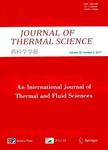Large Eddy Simulation of NO Formation in Non-Premixed Turbulent Jet Flames with Flamelet/Progress Variable Approach
作者机构:State Key Laboratory of Coal CombustionSchool of Energy and Power EngineeringHuazhong University of Science and Technology (HUST) CCRCKing Abdullah University of Science and Technology (KAUST)
出 版 物:《Journal of Thermal Science》 (热科学学报(英文版))
年 卷 期:2024年第33卷第6期
页 面:2399-2412页
核心收录:
学科分类:08[工学] 0817[工学-化学工程与技术] 081701[工学-化学工程]
基 金:financially supported by the National Natural Science Foundation of China (51906075) the National Key Research and Development Program of China (2019YFE0100100)
主 题:flamelet/progress variable model large eddy simulation NO emission Sandia flames
摘 要:To improve the NO modelling in turbulent flames,the flamelet/progress variable(FPV) model is extended by introducing NO mass fraction into the progress variable and incorporating an additional NO transport *** sets of flamelet databases are tabulated with progress variables based on major species and NO mass fraction,*** former is used for the acquisition of the main thermochemical variables,while the latter is employed for NO ***,an additional transport equation is solved to obtain the NO mass fraction,with the source term corrected using the scale similarity *** assessments are first conducted on laminar counterflow diffusion flames to identify lookup-related errors and assess the suitability of progress variable *** results show that the progress variables based on major species and NO could correctly describe the main thermochemical quantities and NO-related variables,***,the model is applied to the large eddy simulation(LES) of Sandia *** results indicate that the extended FPV model improves the NO prediction,with a mean error for NO prediction at 55%,significantly lower than those of existing FPV models(130% and 385%).The LES with the extended FPV model quantitatively captures NO suppression in the mid-range of Reynolds numbers from 22 400(Flame D) to 33 600(Flame E),but underestimates the NO suppression at higher Reynolds numbers from 33 600 to 44 800(Flame F).This underprediction is primarily attributed to the underestimation of local extinction levels in flames with high Reynolds numbers.



